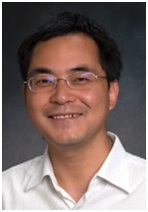【通信与信息工程学院】蜂窝移动和车联网网络中的联合通信和感知技术
报告题目:Joint Communication and Sensing for Cellular and Vehicular Communication Networks
报告人:professor J. Andrew Zhang, School of Electrical and Data Engineering/ Global Big Data Technologies Centre Faculty of Engineering and Information Technology University of Technology Sydney
时间:12月22日(周五)上午9:00
地点:三牌楼校区科研楼208
主办单位:通信与信息工程学院、通信技术研究所

报告人简介: Dr J. Andrew Zhang (M'04-SM'11) received the B.Sc. degree from Xi'an JiaoTong University, China, in 1996, the M.Sc. degree from Nanjing University of Posts and Telecommunications, China, in 1999, and the Ph.D. degree from the Australian National University, in 2004. Currently, Dr. Zhang is an associate Professor in School of Computing and Communications, University of Technology Sydney, Australia. He was a researcher with Data61, CSIRO, Australia from 2010 to 2016, the Networked Systems, NICTA, Australia from 2004 to 2010, and ZTE Corp, Nanjing, China from 1999 to 2001. Dr. Zhang's research interests are in the area of signal processing for wireless communications and sensing, and autonomous vehicular networks. He has published more than 120 papers in leading international Journals and conference proceedings, and has won 4 best paper awards for his work. He is a recipient of CSIRO Chairman's Medal and the Australian Engineering Innovation Award in 2012 for exceptional research achievements in multi-gigabit wireless communications.
报告内容: Radio science and engineering has been advancing in wireless communication and radar sensing in parallel and with limited intersections over a century. Performing joint communication and sensing (JCAS), however, offers substantial benefits including the potential for shared spectrum and hardware, which is valuable for emerging platforms such as unmanned aerial vehicles and smart cars. Sensing here refers to information retrieval through measuring spatial parameters such as location and moving speed and physical parameters such as shape and hardware characteristics, of static and moving objects using radio signals. Integrating the two functions of communication and sensing into one system can achieve immediate benefits of reduced cost, size, weight, and better spectrum efficiency.
In this talk, we will first have a brief review on the motivation for JCAS and the basic approaches, and then focus on discussing our innovative and pioneering JCAS work in two areas: Perceptive cellular networks, and perceptive point-to-point (P2P) links. For the perceptive cellular networks, we will discuss how to enable the next generation mobile networks, such as 5G, to do radio sensing, using complex multiuser MIMO OFDMA signals. For the perceptive point-to-point links, we will show how to use two (millimetre-wave) phased antenna arrays and multibeam beamforming to achieve JCAS, which can be very useful for simultaneous communication and collision avoidance in smart car applications. The talk will be concluded with a discussion on open research problems.
地址:南京邮电大学亚东新城区文苑路9号(210023) 电话:025-85866911 传真:025-85866911 Email:kxjsc@njupt.edu.cn
Copyright © www.njupt.edu.cn All Rights Reserved
